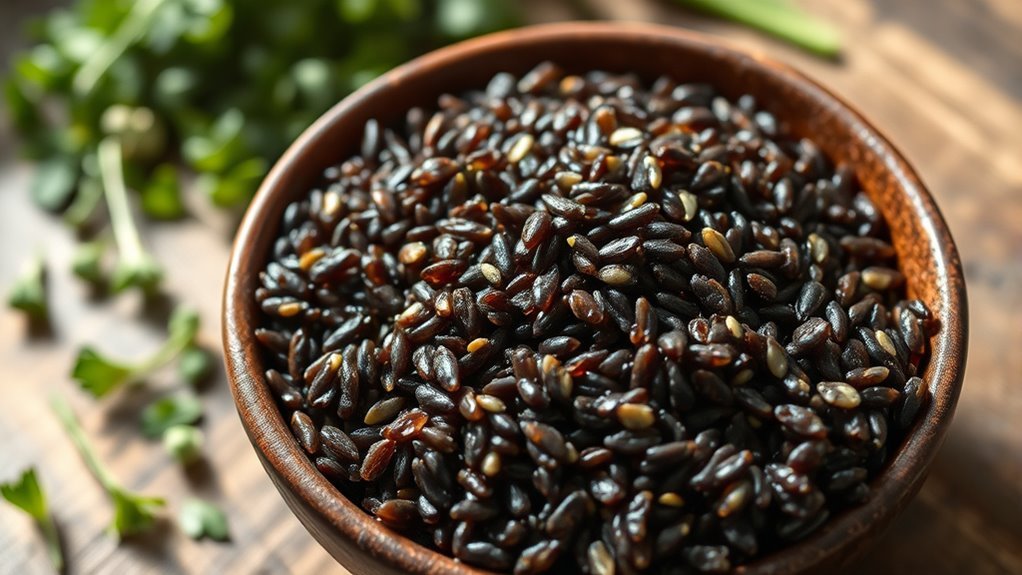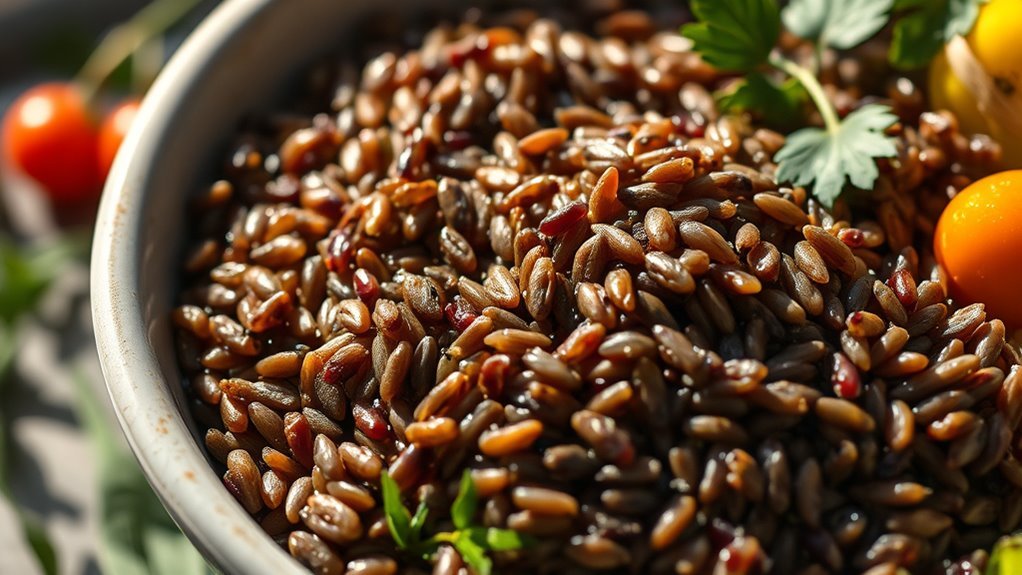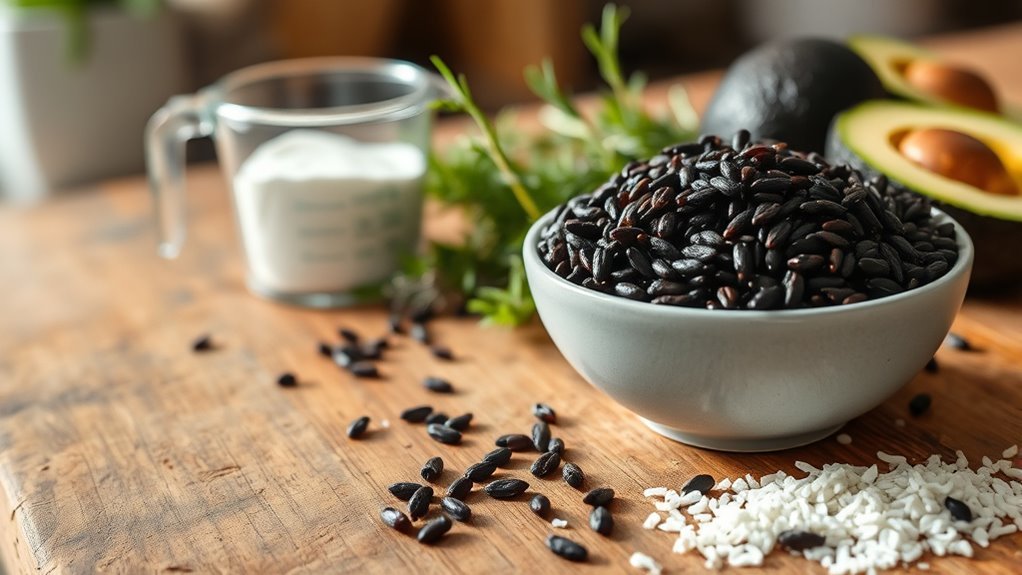While wild rice isn’t typically deemed keto-friendly due to its higher carbohydrate content—about 35 grams per cup—small portions may fit into a carefully managed meal plan. Its rich protein and fiber content make it a nutritious choice, but exceeding carb limits can hinder ketosis. To maintain your diet goals, consider portion control or low-carb alternatives. Discover more about how wild rice compares to other grains and what options might work for you.
Understanding the Nutritional Profile of Wild Rice

When exploring the nutritional profile of wild rice, it’s essential to recognize that this unique grain differs markedly from traditional rice varieties. Wild rice boasts a higher nutritional density, providing more vitamins and minerals per serving. For instance, it’s rich in protein, fiber, and antioxidants, making it a healthy choice for those seeking to enhance their diet. You’ll also find essential minerals like magnesium, zinc, and phosphorus, which can support overall health. Unlike standard white rice, wild rice offers a nuttier flavor and chewy texture that can elevate your meals. Incorporating wild rice into your diet can be a flavorful way to boost your nutrient intake while enjoying the freedom of diverse culinary options.
Carbohydrate Content in Wild Rice

When considering wild rice in a keto diet, it’s crucial to look at its carbohydrate content. Typically, cooked wild rice contains about 35 grams of carbs per cup, which can impact your daily carb limit. Additionally, understanding its glycemic index can help you assess how it may affect your blood sugar levels compared to other grains.
Carb Count Overview
Wild rice, often celebrated for its nutty flavor and chewy texture, contains a notable amount of carbohydrates that can impact your keto diet. While it offers various wild rice benefits, like being high in protein and fiber, it’s crucial to reflect on its carb count when planning your keto meal. Here’s a quick overview:
| Serving Size | Total Carbs | Net Carbs |
|---|---|---|
| 1 cup cooked | 35g | 30g |
| 1/2 cup cooked | 17g | 15g |
| 1/4 cup cooked | 9g | 8g |
As you can see, each serving packs in carbs, so if you’re aiming to stay under 20-50g of carbs daily, you may want to enjoy wild rice in moderation.
Glycemic Index Comparison
Although many people enjoy wild rice for its unique taste and nutritional benefits, understanding its glycemic index (GI) is vital for those on a keto diet. Wild rice has a GI ranging from 50 to 87, depending on how it’s prepared. This means it can cause a moderate spike in blood sugar levels compared to other low-GI foods. For individuals monitoring their carbohydrate intake and blood sugar responses, this is significant information. While wild rice provides essential nutrients and fiber, it may not align well with strict keto guidelines, where low-GI foods are favored. If you’re looking to maintain stable blood sugar while on a keto diet, consider portion control or alternative low-carb options.
Comparing Wild Rice to Other Grains

When comparing wild rice to other grains, it’s important to evaluate their nutritional profiles and carbohydrate content. Wild rice typically offers a unique blend of vitamins, minerals, and fiber, which can provide distinct health benefits. Understanding these differences can help you make informed choices that align with your dietary goals.
Nutritional Profile Comparison
While many grains are staples in diets around the world, their nutritional profiles can vary considerably. Wild rice stands out due to its impressive nutrient density, offering more protein and fiber than typical grains like white rice or pasta. It’s rich in antioxidants, vitamins, and minerals that contribute to overall health. For example, the wild rice benefits include supporting heart health and aiding digestion, making it a fantastic option for those seeking more than just calories. In contrast, common grains often lack these nutritional advantages, leading to less satisfying meals. By choosing wild rice, you’re not only diversifying your diet but also enhancing your nutritional intake, which is essential for maintaining your freedom to thrive.
Carb Content Analysis
Understanding the carb content in wild rice is essential for those following a keto diet. While wild rice offers a unique flavor and texture, its carbohydrate levels can impact your daily intake. Below is a comparison of wild rice to other common grains, highlighting their fiber content and typical cooking methods.
| Grain | Carbs (per 100g) | Fiber Content (g) |
|---|---|---|
| Wild Rice | 21g | 1.8g |
| Brown Rice | 23g | 1.8g |
| Quinoa | 21g | 2.8g |
| Oats | 66g | 8g |
| Barley | 73g | 17g |
Consider these figures when planning meals. Cooking methods can also influence carb absorption, so keep that in mind!
Health Benefits Overview
Although wild rice may not be as commonly consumed as other grains, it offers a range of health benefits that can enhance your diet. One of its key nutritional advantages is its high dietary fiber content, which supports digestive health and helps maintain stable blood sugar levels. Unlike white rice, wild rice is also rich in antioxidants and essential minerals, such as magnesium and phosphorus, contributing to overall wellness. By incorporating wild rice into your meals, you can enjoy a more nutrient-dense option compared to many refined grains. This can be especially beneficial for those seeking to diversify their carbohydrate sources while enjoying a wholesome, satisfying grain that aligns with healthful eating goals.
Health Benefits of Wild Rice
If you’re looking for a nutritious addition to your diet, wild rice offers a variety of health benefits that can support overall well-being. Its impressive nutrient density provides essential vitamins and minerals while being low in calories. Plus, its antioxidant properties help combat oxidative stress, potentially reducing the risk of chronic diseases.
Here’s a quick overview of wild rice’s benefits:
| Benefits | Details |
|---|---|
| Nutrient Density | High in protein, fiber, and minerals |
| Antioxidant Properties | Rich in phenolic compounds |
| Heart Health | May lower cholesterol levels |
| Digestive Health | Supports gut health due to fiber content |
Incorporating wild rice into your meals can contribute to a healthier lifestyle, enhancing your freedom to enjoy delicious, nutritious food.
How Wild Rice Fits Into a Keto Diet
Wild rice, with its impressive nutrient profile, can spark curiosity about its compatibility with a ketogenic diet. While it’s higher in carbohydrates than typical keto-friendly foods, the dietary fibers in wild rice may offer benefits when included in moderation. If you’re meal planning, consider using it as a grain alternative, balancing portion sizes to fit your macros. Cooking methods like steaming or boiling can help maintain its flavor profile and nutritional benefits without adding excessive carbs. However, it’s crucial to weigh health considerations, such as individual carb limits and overall dietary goals. Ultimately, wild rice can have a place in your keto diet, but mindful integration is key to staying on track with your health objectives.
Portion Control and Serving Suggestions
When incorporating wild rice into your keto meal plan, portion control is essential to guarantee you stay within your carbohydrate limits. While wild rice offers a unique flavor and some nutritional benefits, it contains about 32 grams of carbs per cooked cup. To maintain a keto-friendly diet, consider limiting your portion sizes to about half a cup. This way, you can enjoy the taste without exceeding your carb allowance.
For serving suggestions, pair wild rice with low-carb vegetables, grilled meats, or a rich sauce to enhance your meal. You could also mix small amounts of wild rice into salads or soups, allowing you to savor its flavor while keeping your carb intake balanced.
Alternatives to Wild Rice for Keto Dieters
What can you substitute for wild rice on a keto diet? If you’re looking for keto-friendly substitutes, consider these low carb grains that won’t kick you out of ketosis:
| Substitute | Carbs (per 100g) | Notes |
|---|---|---|
| Cauliflower Rice | 3g | Excellent texture, versatile. |
| Shredded Cabbage | 2g | Great for stir-fries and salads. |
| Zucchini Noodles | 3g | Light and revitalizing option. |
| Shirataki Rice | 1g | Low-calorie, absorbs flavors well. |
| Konjac Rice | 1g | Very low in calories and carbs. |
These options not only help you maintain your keto lifestyle but also add variety to your meals, giving you the freedom to enjoy delicious dishes while staying on track.
Final Thoughts on Wild Rice and Keto Compatibility
While there are several keto-friendly alternatives to wild rice, understanding its compatibility with a ketogenic diet is important for those considering their options. Wild rice isn’t typically considered keto due to its higher carbohydrate content, which can hinder ketosis if consumed in large amounts. However, it does offer nutritional benefits, including fiber and protein. It’s crucial to dispel keto myths that label all grains as off-limits. If you’re managing your carb intake carefully, small portions of wild rice can occasionally fit into your meal plan. Ultimately, your dietary freedom allows you to choose what works for you. Just remember to balance your meals and prioritize low-carb options for best results on your keto journey.
Frequently Asked Questions
Can I Eat Wild Rice on a Strict Ketogenic Diet?
Imagine a river flowing through a lush landscape, where choices ripple out before you. On a strict ketogenic diet, you’re charting the waters of nutrition, seeking the right balance. Wild rice, while a hearty grain, is higher in carbs than typical keto staples. It can disrupt your low-carb goals. If you’re committed to the ketogenic path, it’s best to steer clear and explore alternatives that keep you on course. Freedom lies in mindful choices.
How Does Wild Rice Affect Blood Sugar Levels?
When considering how wild rice affects blood sugar levels, it’s important to note that it has a relatively low glycemic index compared to white rice. This means it’s less likely to cause rapid spikes in blood sugar. However, since wild rice contains carbohydrates, consuming it in moderation is key, especially if you’re monitoring your blood sugar. Balancing it with proteins and fats can help maintain stable levels and give you more freedom in your diet.
Is Wild Rice Gluten-Free?
You might be surprised to learn that wild rice is indeed gluten-free! This nutrient-packed grain offers numerous nutritional benefits, making it a fantastic choice for those avoiding gluten. It’s high in protein and fiber, which can help keep you feeling full. If you’re looking for wild rice alternatives, consider quinoa or millet, as they also provide similar health advantages. Embracing gluten-free options can truly enhance your culinary freedom and overall well-being.
Can Wild Rice Be Used in Keto Recipes?
While you might be tempted to use wild rice in your keto recipes, it’s important to note that it’s higher in carbs compared to keto-friendly grains like cauliflower rice or shirataki rice. If you’re looking for wild rice alternatives, consider these options to keep your meals low in carbs. This way, you can enjoy flavorful dishes without compromising your keto goals, allowing for more freedom in your dietary choices.
How Should Wild Rice Be Stored for Freshness?
Wondering how to keep your wild rice fresh? For ideal wild rice storage, keep it in an airtight container in a cool, dark place. This helps maintain its flavor and texture. If you’ve cooked it, refrigerate leftovers in a sealed container for up to a week. To extend its shelf life even further, consider freezing it. Following these freshness tips will guarantee your wild rice stays delicious for your culinary adventures!


